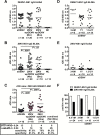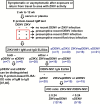Distinguishing Secondary Dengue Virus Infection From Zika Virus Infection With Previous Dengue by a Combination of 3 Simple Serological Tests
- PMID: 29020159
- PMCID: PMC5850648
- DOI: 10.1093/cid/cix672
Distinguishing Secondary Dengue Virus Infection From Zika Virus Infection With Previous Dengue by a Combination of 3 Simple Serological Tests
Abstract
Background: The explosive spread of Zika virus (ZIKV) and associated microcephaly present an urgent need for sensitive and specific serodiagnostic tests, particularly for pregnant women in dengue virus (DENV)-endemic regions. Recent reports of enhanced ZIKV replication by dengue-immune sera have raised concerns about the role of previous DENV infection on the risk and severity of microcephaly and other ZIKV complications.
Methods: Enzyme-linked immunosorbent assays (ELISAs) based on ZIKV and DENV nonstructural protein 1 (NS1) were established to test acute, convalescent phase, and post-convalescent phase serum/plasma samples from reverse-transcription polymerase chain reaction-confirmed cases including 20 primary ZIKV, 25 ZIKV with previous DENV, 58 secondary DENV, and 16 primary DENV1 infections.
Results: ZIKV-NS1 immunoglobulin M (IgM) and immunoglobulin G (IgG) ELISAs combined can detect ZIKV infection with a sensitivity of 95% and specificity of 66.7%. The ZIKV-NS1 IgG cross-reactivity by samples from secondary DENV infection cases ranged from 66.7% to 28.1% (within 1 month to 1-2 years post-illness, respectively). Addition of DENV1-NS1 IgG ELISA can distinguish primary ZIKV infection; the ratio of absorbance of ZIKV-NS1 to DENV1-NS1 IgG ELISA can distinguish ZIKV with previous DENV and secondary DENV infections with a sensitivity of 87.5% and specificity of 81.3%. These findings were supported by analysis of sequential samples.
Conclusions: An algorithm for ZIKV serodiagnosis based on 3 simple ELISAs is proposed to distinguish primary ZIKV, ZIKV with previous DENV, and secondary DENV infections; this could be applied to serodiagnosis for ZIKV, serosurveillance, and monitoring ZIKV infection during pregnancy to understand the epidemiology, pathogenesis, and complications of ZIKV in dengue-endemic regions.
Keywords: Zika virus; cross-reactivity; dengue virus; non-structural protein 1; serological test.
© The Author 2017. Published by Oxford University Press for the Infectious Diseases Society of America. All rights reserved. For permissions, e-mail: journals.permissions@oup.com.
Figures



Similar articles
-
Combination of Nonstructural Protein 1-Based Enzyme-Linked Immunosorbent Assays Can Detect and Distinguish Various Dengue Virus and Zika Virus Infections.J Clin Microbiol. 2019 Jan 30;57(2):e01464-18. doi: 10.1128/JCM.01464-18. Print 2019 Feb. J Clin Microbiol. 2019. PMID: 30429254 Free PMC article.
-
Comprehensive Evaluation of Differential Serodiagnosis between Zika and Dengue Viral Infections.J Clin Microbiol. 2019 Feb 27;57(3):e01506-18. doi: 10.1128/JCM.01506-18. Print 2019 Mar. J Clin Microbiol. 2019. PMID: 30541932 Free PMC article.
-
A high-throughput and multiplex microsphere immunoassay based on non-structural protein 1 can discriminate three flavivirus infections.PLoS Negl Trop Dis. 2019 Aug 23;13(8):e0007649. doi: 10.1371/journal.pntd.0007649. eCollection 2019 Aug. PLoS Negl Trop Dis. 2019. PMID: 31442225 Free PMC article.
-
Modulation of Dengue/Zika Virus Pathogenicity by Antibody-Dependent Enhancement and Strategies to Protect Against Enhancement in Zika Virus Infection.Front Immunol. 2018 Apr 23;9:597. doi: 10.3389/fimmu.2018.00597. eCollection 2018. Front Immunol. 2018. PMID: 29740424 Free PMC article. Review.
-
The immunopathology of dengue and Zika virus infections.Curr Opin Immunol. 2017 Oct;48:1-6. doi: 10.1016/j.coi.2017.07.001. Epub 2017 Jul 21. Curr Opin Immunol. 2017. PMID: 28738211 Review.
Cited by
-
Evaluation of ViroTrack Sero Zika IgG/IgM, a New Rapid and Quantitative Zika Serological Diagnostic Assay.Diagnostics (Basel). 2020 Jun 4;10(6):372. doi: 10.3390/diagnostics10060372. Diagnostics (Basel). 2020. PMID: 32512812 Free PMC article.
-
Competitive ELISA for a serologic test to detect dengue serotype-specific anti-NS1 IgGs using high-affinity UB-DNA aptamers.Sci Rep. 2021 Sep 9;11(1):18000. doi: 10.1038/s41598-021-97339-8. Sci Rep. 2021. PMID: 34504185 Free PMC article.
-
Zika virus RNA detection in blood donors in São Paulo, Brazil.Hematol Transfus Cell Ther. 2022 Oct-Dec;44(4):472-477. doi: 10.1016/j.htct.2021.03.007. Epub 2021 May 26. Hematol Transfus Cell Ther. 2022. PMID: 34148860 Free PMC article.
-
Enzyme-linked immunosorbent assays using virus-like particles containing mutations of conserved residues on envelope protein can distinguish three flavivirus infections.Emerg Microbes Infect. 2020 Dec;9(1):1722-1732. doi: 10.1080/22221751.2020.1797540. Emerg Microbes Infect. 2020. PMID: 32684139 Free PMC article.
-
Delayed and highly specific antibody response to nonstructural protein 1 (NS1) revealed during natural human ZIKV infection by NS1-based capture ELISA.BMC Infect Dis. 2018 Jun 14;18(1):275. doi: 10.1186/s12879-018-3173-y. BMC Infect Dis. 2018. PMID: 29898684 Free PMC article.
References
-
- Petersen LR, Jamieson DJ, Powers AM, Honein MA. Zika virus. N Engl J Med 2016; 374:1552–63. - PubMed
-
- Rasmussen SA, Jamieson DJ, Honein MA, Petersen LR. Zika virus and birth defects—reviewing the evidence for causality. N Engl J Med 2016; 374:1981–7. - PubMed
-
- Pierson TC, Diamond MS. Flaviviruses. Knipe DM, Howley PM, eds. Fields virology, 6th ed Philadelphia: Lippincott Williams & Wilkins, 2013:747–94.
MeSH terms
Substances
Grants and funding
LinkOut - more resources
Full Text Sources
Other Literature Sources
Medical
Research Materials

